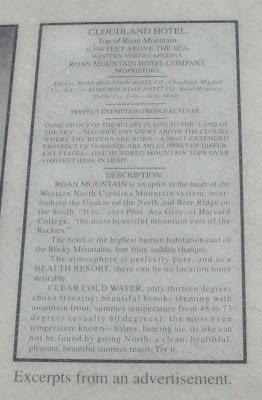
After returning to where I suspected the trailhead might be, I got out and scouted a bit, and sure enough spotted the white blazes and slightly concealed steps leading from roadway to trail. After returning to my car and gearing up, I was off! There was a relatively mild uphill right out of the box, with a nice switchbacked ascent. Next came a rocky clamber over the ridgecrest, then down the other side, which was a bit more steep. I kept smelling burned wood throughout this entire first section, and figured it was from a recent campfire. When I read the AT book, it told me that the area had burned in the 1970s, but I find it hard to believe that I was still smelling that same burn. Still, I saw no fire rings from which the smoky scent might have emanated. After coming down off the ridge, hit a boring half-mile segment of paved road that led to the dam. Approaching from this direction, one of the first views you get is across the gorge, at the myriad striations exposed on the opposite side. I'm sure this is a geologist's dream. Although it's significance it is admittedly somewhat lost on me, I still find it fascinating to see the aeons-old evidence of the violence that shaped these beautiful mountains.
 As I crossed the dam (only AT hikers are allowed to cross the dam, teehee!), I noticed this odd structure. I later found out that it is an emergency spillway. As you can see by the water lines, it has never been challenged, and by the looks of the current levels, probably never will.
As I crossed the dam (only AT hikers are allowed to cross the dam, teehee!), I noticed this odd structure. I later found out that it is an emergency spillway. As you can see by the water lines, it has never been challenged, and by the looks of the current levels, probably never will. On the other side of the dam, the trail ascends again, past a couple of camp sites and along a pleasantly shaded trail to the Watauga Lake AT Shelter.
On the other side of the dam, the trail ascends again, past a couple of camp sites and along a pleasantly shaded trail to the Watauga Lake AT Shelter. On the way back toward the dam, I noticed the color of the lake water in a little inlet was eerily similar to the "glacial green" of which I had seen so much in the fjords of Norway. So naturally, I had to try to capture it with a picture! I'm not sure how well I did, but you can at least see the contrast between the leafy green of the trees and the tranquil blue-green of the lake.
On the way back toward the dam, I noticed the color of the lake water in a little inlet was eerily similar to the "glacial green" of which I had seen so much in the fjords of Norway. So naturally, I had to try to capture it with a picture! I'm not sure how well I did, but you can at least see the contrast between the leafy green of the trees and the tranquil blue-green of the lake.
Here's the view from atop the dam, looking out across the lake. It was a gorgeous sunny day, yet fairly cool and with a very light breeze ruffling the water. Note that I kindly included the plaque with all the dam's stats (remember you can always click a photo and see it full size) so that I don't have to bore the uninterested by typing them out here :).

This is an edge-on view of the back side of the dam. I found its construction method interesting, given that all of my previous dam experience has been with either huge concrete monstrosities like the Hoover Dam, or ugly utilitarian metal construction like the gates damming Lake Manatee in my home state of Florida.

This was probably the most startling view of all, though. The guidebooks had warned me about it, but nothing really prepared me for it. This is the view from the dam looking away from the lake. Not a drop of water visible anywhere. In fact, even the (surprisingly narrow) pipe that takes the water from the dam to the hydroelectric plant was very difficult to see (don't bother looking for it in this pic, it isn't there). I found this especially puzzling considering the graphic on the sign close to the entrance of the park, which shows a definite ribbon of water extending down from the dam on this side (you can see it here, not my photo).

Despite my puzzlement, I managed to complete my hike. The boring stretch of road between dam and trail was just as boring uphill, with only its cardiovascular benefits to recommend it. As for my usual stats, I found it a little difficult to calculate the length of my hike; according to the AT Guide, it was 3.8 miles. According to another guide, Exploring the Appalachian Trail: Hikes in the Southern Appalachians by Doris Gove, it was 4.4 miles. Finally, my trusty GPS reported that I had walked 4.66 miles. In this case, I'm going with the GPS, because I did do quite a bit of wandering hither and yon on and around the dam.
Stats:
Date: 10/10/07
AT Miles covered: 2.33 (x2 = 4.66)
Altitude gain: roughly 480 feet from dam level to top of beginning ridge.












